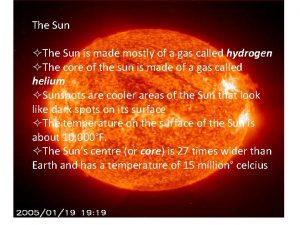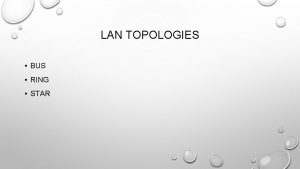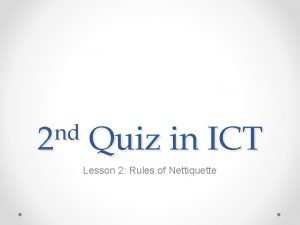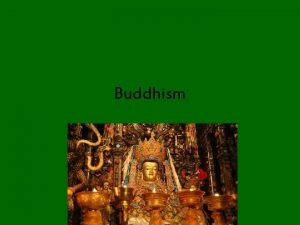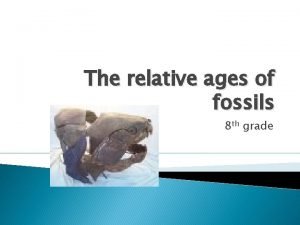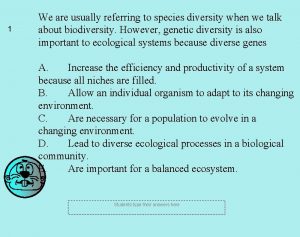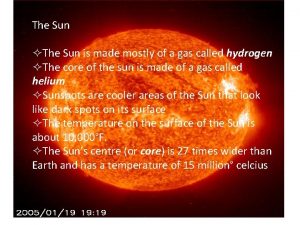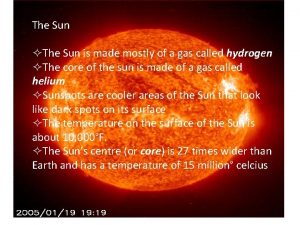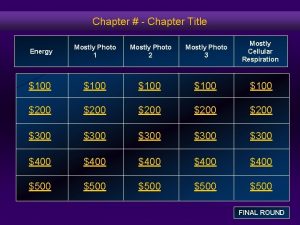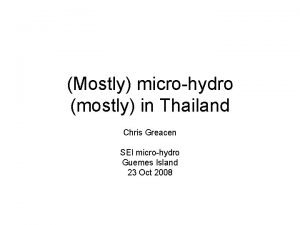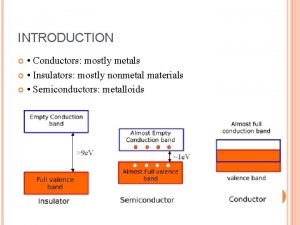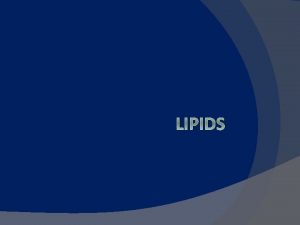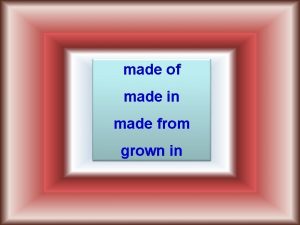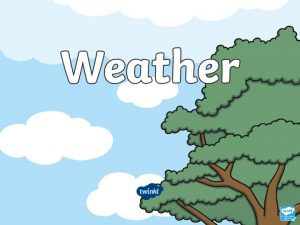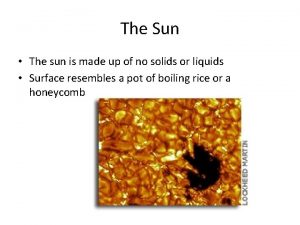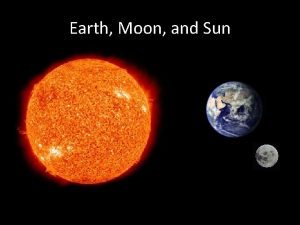The Sun The Sun is made mostly of











- Slides: 11

The Sun ²The Sun is made mostly of a gas called hydrogen ²The core of the sun is made of a gas called helium ²Sunspots are cooler areas of the Sun that look like dark spots on its surface ²The temperature on the surface of the Sun is about 10, 000°F. ²The Sun’s centre (or core) is 27 times wider than Earth and has a temperature of 15 million° celcius

Mercury ²Mercury is the closest planet to the Sun ²During the day Mercury is hot (up to 427°c – over four times hotter than boiling water!), but at night it is freezing cold. This is because there is no atmosphere to keep the Sun’s heat near to the planet. ²Mercury is a rocky planet with a large metal core made of iron and nickel. ²There is no water on Mercury and it is covered in craters. ²It takes Mercury 88 Earth days to orbit the Sun. ²Mercury is 57. 9 million km from the Sun.

Venus ²Is the second planet from the Sun and the closest planet to Earth. It is 108, 000 km from the sun. ²Venus has an atmosphere. A layer of thick, swirling clouds hides the surface of Venus. ²Venus’ atmosphere contains carbon dioxide ²The clouds trap the Sun’s heat and it is hotter on Venus than on Mercury. ²The clouds contain acid. ²Much of the surface of Venus is covered in lava from the many volcanoes on the surface of Venus.

Earth ²Earth is the third planet from the Sun ²Earth is the only planet known in the solar system to have life. ²Much of the Earth’s surface is covered in water ²Earth is constantly spinning, causing only half of its surface to face the Sun at any one time. ²Earth is 149. 6 million km from the Sun ²The Earth’s atmosphere contains oxygen.

The Moon Ø The Moon circles the Earth every 28 days Ø The side of the moon facing the sun is often hotter than boiling water (123⁰c), but the other side is freezing cold (-163⁰c). Ø There is no air on the moon Ø The moon is the only celestial body in the solar system that astronauts have visited. Ø The moon is 384, 400 km from Earth. Ø The Moon has many craters. Ø The dark patches on the surface of the Moon are known as seas – they formed millions of years ago from solid lava.

Mars • Is sometimes called the “Red Planet” because it looks red in the sky from Earth. • Mars is mostly dry desert with craters, canyons and volcanoes. • There are few clouds that cover Mars. The clouds are made of ice, so no rain falls. • Mars is 228 million km from the Sun. • It takes 687 days to orbit the Sun. • Mars has two moons – Deimos and Phobos.

Jupiter • Is the largest planet in the Solar System • Jupiter has a thin, faint ring around it. It is made from time specks of dust. This can’t be seen from Earth. • Jupiter has 63 moons according to NASA – called the Galileo moons. They have been discovered by the Galileo space probe. • The Giant red spot seen on Jupiter is a huge storm in Jupiter’s clouds • Jupiter takes 11. 9 years to orbit the Sun. • Jupiter is 778, 000 km from the Sun. • Jupiter is not a frozen planet because pressurized hydrogen gas at the heart of the planet is generating heat.

Saturn • Saturn has a thin, wide system of rings made of millions of icy chunks of rock moving around the planet. • Saturn is the lightest planet in the solar system • Saturn is nine times wider than the Earth. • It takes Saturn 29. 5 years to orbit the sun. • Saturn is made mostly of hydrogen and helium/ • NASA says there at leaset 31 moons around Saturn. • Saturn is the second largest planet in the solar system • Saturn is spinning so fast that it appears to bulge out in the middle, and be squashed at the poles. • It is 1, 429, 000 km (1, 429 million km) from the Sun

Uranus • The third largest planet in the solar system • Blue and green clouds surround Uranus • It was the first planet to be discovered – in 1781 by a telescope. • It is 2, 870 million km away from the Sun • There at least 22 moons • It takes 84 years to orbit the Sun.

Neptune • Is the smallest gas planet and eighth planet from the Sun. • Blue clouds and white clouds cover the surface of Neptune • It is 4, 504 million km from the Sun • It takes about 165 Earth years to orbit the Sun • Winds around Neptune can reach 2, 000 km an hour – a Formula One car can reach around 250 km an hour. • Neptune has 12 moons.

Pluto • Is no longer regarded as a planet • Recently scientists have discovered that Pluto is made up only of rock and ice and is 5 times lighter than Earth, and 3 times smaller. • Scientists now call Pluto a dwarf planet, because it is comparatively smaller. • Pluto takes 248 years to travel once around the Sun • Pluto is 4, 425 million km from the Sun. Its orbit can take it as far as 7, 375 million km away from the Sun! • It takes 12 years fro a space probe to get there, so we know relatively little about Pluto!
 Earth the third planet from the sun
Earth the third planet from the sun Four outer planets in order
Four outer planets in order Horace morris but mostly dolores
Horace morris but mostly dolores Bus, ring and star topologies mostly used in the
Bus, ring and star topologies mostly used in the Where can we mostly asteroid found
Where can we mostly asteroid found A program designed to send you advertisement mostly pop-ups
A program designed to send you advertisement mostly pop-ups Where is buddhism mostly located
Where is buddhism mostly located Kingdom protista unicellular or multicellular
Kingdom protista unicellular or multicellular Concealed puncture wounds meaning
Concealed puncture wounds meaning Strata are mostly found brainpop quizlet
Strata are mostly found brainpop quizlet Lions are mostly nocturnal predators phrase or clause
Lions are mostly nocturnal predators phrase or clause The main reason that there are relatively few invertebrates
The main reason that there are relatively few invertebrates
